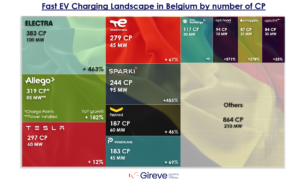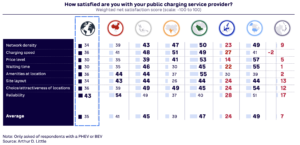The growth in the number of charging points has been particularly notable in both alternating current (AC) and direct current (DC) charging facilities. AC charging points, which make up around 84% of Europe’s public charging infrastructure, have seen an increase of about 35% compared to the figures at the end of 2022. On the other hand, DC charging points, although fewer in number, have shown a more remarkable growth rate of 61% over the same period. This disproportionate growth indicates a strategic push towards faster charging options to support the increasing number of battery electric vehicles (BEVs) on the road.
Denmark and Belgium have emerged as leaders in this expansion, recording the most significant growth rates in AC and DC charging points, respectively. Denmark’s AC chargers grew by an unprecedented 109% in 2023, while Belgium topped the charts for DC charger growth with a 154% increase. These figures not only reflect the countries’ commitment to electrifying their transport sectors but also their efforts to create a more accessible and convenient charging network for EV users.
At the end of December 2023, the density of charging points across Europe averaged about 4.2 22 kW-equivalent publicly accessible charging points per thousand passenger cars and vans, a notable increase from 3.8 at the end of September. Norway continues to lead the way in charging infrastructure density, boasting nearly 31 22 kW-equivalent charging points per thousand passenger cars and vans. This is followed by Iceland, the Netherlands, Denmark, and Sweden, all of which significantly exceed the European average. In contrast, Italy and Spain lag behind, with charging point densities of 1.9 and 1.7, respectively, underscoring the uneven development of charging infrastructure across the continent.
The substantial growth in Europe’s EV charging infrastructure is a testament to the continent’s steadfast dedication to combating climate change and reducing greenhouse gas emissions through the promotion of electric mobility. By expanding the availability of both AC and DC charging options, Europe is not only facilitating the transition to electric vehicles but also ensuring that the charging infrastructure can keep pace with the increasing demand. This development is crucial for the continent’s ambition to achieve carbon neutrality and for the global effort to mitigate the impacts of climate change.
As we move forward, the continued expansion and enhancement of the EV charging infrastructure will be critical. This includes not just increasing the number of charging points but also improving their geographic distribution and accessibility to address current disparities and ensure that the transition to electric mobility is inclusive and equitable across all European nations.
Source: European car and van market and charging Infrastructure development: january–December 2023 | The ICCT




